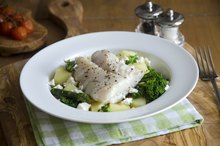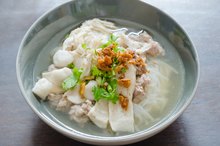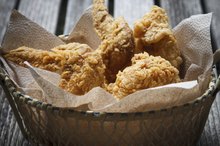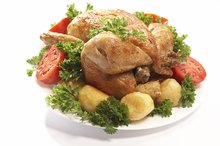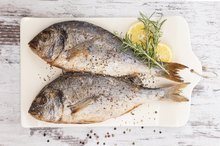What does fact checked mean?
At Healthfully, we strive to deliver objective content that is accurate and up-to-date. Our team periodically reviews articles in order to ensure content quality. The sources cited below consist of evidence from peer-reviewed journals, prominent medical organizations, academic associations, and government data.
- Harvard School of Public Health: Protein -- Moving Closer to Center Stage
- Food and Drug Administration: Food Labeling Guide: Appendix F: Calculate the Percent Daily Value for the Appropriate Nutrients
The information contained on this site is for informational purposes only, and should not be used as a substitute for the advice of a professional health care provider. Please check with the appropriate physician regarding health questions and concerns. Although we strive to deliver accurate and up-to-date information, no guarantee to that effect is made.
Nutritional Value of Hamachi Kama
Hamachi kama is the collar of a yellowtail fish and is common in sushi. These fish are farmed in open-net pens, and the Monterey Bay Aquarium warns that hamachi kama might have a negative impact on the environment due to their high feed requirements and potential for spreading parasites. Despite these worries, hamachi kama is a healthy choice at Japanese restaurants because of its nutritional value.
Calories and Protein
A 3.5-ounce serving of raw hamachi kama has 146 calories and 0 grams of carbohydrates. It has 23 grams of protein, or 46 percent of the daily value. Protein is necessary for maintaining lean muscle mass and other tissues in your body, and it can help you control your weight because it is a filling nutrient, according to the Harvard School of Public Health 3. The exact nutritional value of your meal with hamachi kama depends on how it is prepared.
- A 3.5-ounce serving of raw hamachi kama has 146 calories and 0 grams of carbohydrates.
- Protein is necessary for maintaining lean muscle mass and other tissues in your body, and it can help you control your weight because it is a filling nutrient, according to the Harvard School of Public Health 3.
Fat
Baked Haddock Nutritional Values
Learn More
Hamachi kama has 5.2 grams of total fat, but only 1.3 grams of saturated fat in 3.5 ounces. Saturated fat raises levels of cholesterol in your blood and might increase your risk for heart disease, according to the 2010 Dietary Guidelines from the U.S. Department of Health and Human Services 2. The recommended daily maximum for healthy adults is to get no more than 10 percent of calories from saturated fat, or 22 grams per day on a 2,000-calorie diet. A serving of hamachi kama has 2 grams of monounsaturated fat and 1.4 grams of polyunsaturated fat.
- Hamachi kama has 5.2 grams of total fat, but only 1.3 grams of saturated fat in 3.5 ounces.
Sodium
Each serving of plain hamachi kama has 420 milligrams of potassium and only 39 milligrams of sodium. A low-sodium, high-potassium diet can help you maintain normal blood pressure levels and lower your risk for heart disease and stroke. According to the 2010 Dietary Guidelines from the U.S. Department of Health and Human Services, healthy adults should get at least 4,700 milligrams of potassium and no more than 2,300 milligrams of sodium per day 2. Yellowtail served with soy sauce or another salty condiment will be higher in sodium.
- Each serving of plain hamachi kama has 420 milligrams of potassium and only 39 milligrams of sodium.
- According to the 2010 Dietary Guidelines from the U.S. Department of Health and Human Services, healthy adults should get at least 4,700 milligrams of potassium and no more than 2,300 milligrams of sodium per day 2.
Other Information
How Many Calories in Vietnamese Food?
Learn More
Cholesterol is not an essential nutrient, and cholesterol from your food raises levels of cholesterol in your blood, according to the 2010 Dietary Guidelines from the U.S. Department of Health and Human Services 2. A 3.5-ounce serving of yellowtail has 55 milligrams of cholesterol, or 18 percent of the daily value. The fish has 1.3 micrograms of vitamin B-12, or 11 percent of the daily value, and 6.8 milligrams of niacin, or 34 percent of the daily value. Vitamin B-12 assists in the production of red blood cells, food metabolism and helps maintain a healthy central nervous system. Niacin also aids in production of blood cells and helps maintain healthy skin and digestive system.
- Cholesterol is not an essential nutrient, and cholesterol from your food raises levels of cholesterol in your blood, according to the 2010 Dietary Guidelines from the U.S. Department of Health and Human Services 2.
- The fish has 1.3 micrograms of vitamin B-12, or 11 percent of the daily value, and 6.8 milligrams of niacin, or 34 percent of the daily value.
Related Articles
References
Writer Bio
Natalie Stein specializes in weight loss and sports nutrition. She is based in Los Angeles and is an assistant professor with the Program for Public Health at Michigan State University. Stein holds a master of science degree in nutrition and a master of public health degree from Michigan State University.
